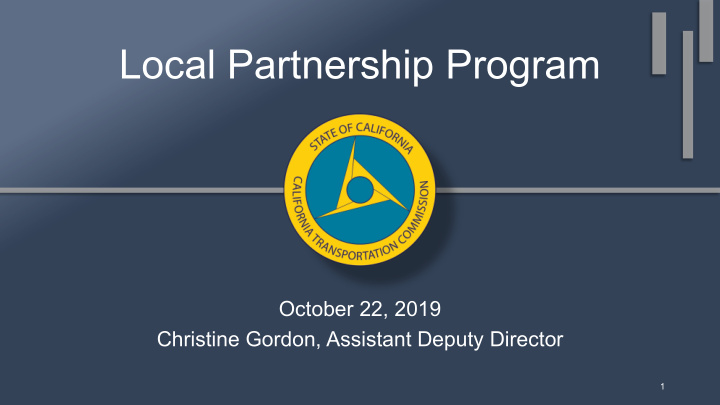



Local Partnership Program October 22, 2019 Christine Gordon, Assistant Deputy Director 1
Go ToWebinar Logistics • Feedback on sound quality and webinar interface • Access to handouts • How to engage in the discussion • For any troubleshooting tips, type them into the question pane • If you are unable to access the webinar please email Elika.Changizi@catc.ca.gov 2
Program Schedule Formula and Competitive Programs Draft Guidelines January 29-30, 2020 Adopt Guidelines March 25-26, 2020 Call for Projects March 25-26, 2020 Application Due May 18, 2020 Staff Recommendations September 15, 2020 Program Adoption October 14-15, 2020 Formula Funding Distribution Publish Proposed Formula Funding Distribution January 15, 2020 Adopt Formula Funding Distribution March 25-26, 2020 3
Recap of Workshops •Previously held three workshops •Key topics discussed •Future workshop topics 4
Proposed - Programming Cycle 2020 Formula Program • 3 years (FY 2020-21 through 2022-23) • Future programming will cover 2 years 2020 Competitive Program • 3 years (FY 2020-21 through 2022-23) • Future programming will be revisited to align with other competitive programs (TCEP and SCCP) 5
Program Distribution 6
Basis of Formula Funding Distribution 7
Performance Metrics 8
Performance Metrics Formula Program • Reporting Competitive Program • Reporting • Evaluation 9
Performance Metrics Commonly Used Tools, Methodologies and Data Sources: • Cal B/C Models • Regional or Sub-Regional Travel Demand Model • Interim ATP Count Guidance • Federal Transportation Performance Management Guidance • Statewide Integrated Traffic Records System (SWITRS) • AASHTO Highway Safety Manual • Transportation Injury Mapping Systems (TIMS) • California Air Resources Board Models (Air Quality, Jobs) • CalEnviroScreen • GIS mapping • General Transit Feed Specification (GTFS) • Existing methodologies utilized 10
Performance Measures – Evaluation (Competitive) Evaluation Criteria Performance Measures Cost-Effective 1.) Cost Effectiveness Air Quality Improvements 1.) Air Quality & Greenhouse Gas Reduction in Vehicle Miles Traveled 1.) Congestion 2.) Throughput 3.) Reliability Regional and Community Support 1.) Safety 2.) Economic Development Disadvantaged Communities 1.) Accessibility 11
Performance Metrics COST-EFFECTIVENESS Required • Cost Benefit Ratio Optional • Other information for narrative discussion 12
Performance Metrics AIR QUALITY & GREENHOUSE GAS Required • Particulate Matter (PM 2.5, PM 10) • Carbon Dioxide (CO2) • Volatile Organic Compounds (VOC) • Sulphur Dioxides (SOx) • Carbon Monoxide (CO) • Nitrogen Oxides (NOx) Optional • None 13
Performance Metrics CONGESTION Required • Project Area, Corridor, County, or Regionwide Vehicle Miles Traveled Per Capita and total Vehicle Miles Traveled • Person Hours of Travel Time Saved • Daily Vehicle Hours of Delay Optional • Percent Change in Non-Single Occupancy Vehicle Travel • Per Capita and Total Person Hours of Delay Per Year • Other information for narrative discussion 14
Performance Metrics THROUGHPUT Required • None Optional • Peak Period Person Throughput by Applicable Mode • Passengers Per Vehicle Service Hour • Bicyclist/Pedestrian Screen Line Counts • Other information for narrative discussion 15
Performance Metrics RELIABILITY Required • Peak Period Travel Time Reliability Index • Transit Service On-Time Performance Optional • Other information for narrative discussion 16
Performance Metrics SAFETY Required • Number of Fatalities • Rate of Fatalities per 100 Million Vehicle Miles Traveled • Number of Serious Injuries • Number of Serious Injuries per Million Vehicle Miles Traveled • Number of Non-Motorized Fatalities and Non-Motorized Serious Injuries Optional • Number or Rate of Property Damage Only and Non-Serious Injury Collisions • Accident Cost Savings • Other information for narrative discussion 17
Performance Metrics ECONOMIC DEVELOPMENT Required • Jobs Created (Direct or Indirect) Optional • Other information for narrative discussion 18
Performance Metrics ACCESSIBILITY Required • Number of Jobs Accessible by Mode • Access to Key Destinations by Mode • % of Population Defined as Low-Income or Disadvantaged Within ½ Mile of a Rail Station, Ferry Terminal, or High- Frequency Bus Stop Optional • Other information for narrative discussion 19
Other Key Topics for Discussion 20
Next Steps •Draft Discussion Guidelines •Next Workshops 21
Thank You! More Information catc.ca.gov RebuildingCA.ca.gov Email: ctc@catc.ca.gov @California_CTC facebook.com/CATransportationCommission 22
Recommend
More recommend